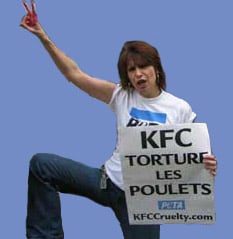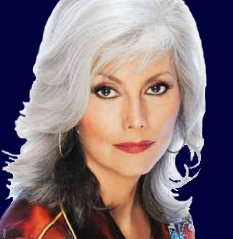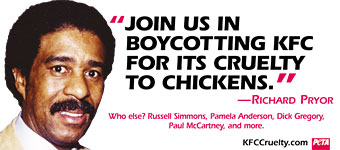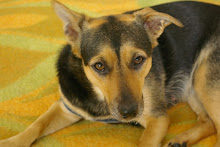KFC suppliers cram birds into huge waste-filled factories, breed and drug them to grow so large that they can’t even walk, and often break their wings and legs. At slaughter, the birds’ throats are slit and they are dropped into tanks of scalding-hot water—often while they are still conscious. It would be illegal for KFC to abuse dogs, cats, pigs, or cows in these ways.
KFC’s own animal welfare advisors have asked the company to take steps to eliminate these abuses, but KFC refuses to do so. Many advisors have now resigned in frustration.
Please join Pamela Anderson, Sir Paul McCartney, His Holiness the Dalai Lama, The Rev. Al Sharpton, and countless other kind people worldwide by not eating at KFC.
Why KFC?
- The roughly 1 billion chickens killed each year for KFC's buckets are crammed by the tens of thousands into excrement-filled sheds that stink of ammonia fumes.
- The birds’ legs and wings often break because they’re bred to be too top-heavy and because workers carelessly shove them into transport crates and shackles.
- Chickens’ throats are slit and the animals are dropped into tanks of scalding-hot water to remove their feathers, often while they are still conscious and able to feel pain.
- KFC lets frustrated factory-farm and slaughterhouse workers handle live birds, so many of the animals end up being sadistically abused. At a KFC “Supplier of the Year” slaughterhouse in West Virginia, workers were documented tearing the heads off live birds, spitting tobacco into their eyes, spray-painting their faces, and violently stomping on them. This was discovered more than two years after KFC promised PETA that it was taking animal welfare seriously.
- KFC hides behind its Animal Welfare Advisory Council, even though five members of the council have resigned in frustration. One of them, Adele Douglass, told the Chicago Tribune that KFC “never had any meetings. They never asked any advice, and then they touted to the press that they had this animal-welfare advisory committee. I felt like I was being used.”
How KFC Can Clean Up Its Act
PETA wants KFC to adopt the animal welfare program developed by five members of its own animal welfare board. These advisors are the world’s top poultry experts; they advise the meat industry in North America and Europe and believe that KFC can—and should—adopt them. KFC has yet to do any of the following:
- Adopt the “Animal Care Standards” program. This would lower the amount of ammonia in the air in factory farms, improve the living spaces and lighting in chicken sheds, prohibit the intentional starving of breeding birds, and ensure that birds are provided with mental and physical stimulation.
- Switch to controlled-atmosphere killing (CAK). This would prevent live birds in slaughterhouses from being abused by workers, having their throats slit, or being scalded while they were still conscious. CAK would also improve conditions for workers and decrease contamination levels in chickens’ flesh.
- Switch to mechanized chicken gathering. This would drastically reduce the number of broken bones and painful bruising that birds endure when factory-farm workers carelessly throw them into transport crates.
- Breed for health rather than rapid growth, and stop feeding drugs to chickens. This would reduce the rate at which birds suffer painful, crippling diseases and injuries, such as broken legs, heart attacks, and lung failures.
- Make all welfare standards transparent and verifiable. This would simply ensure that the animal welfare program is being adhered to through announced and unannounced independent audits (the results of which must be made available to the public through KFC’s Web site).
Undercover investigation
“[KFC] never had any meetings. They never asked any advice, and then they touted to the press that they had this animal-welfare advisory committee. I felt like I was being used.”
—Dr. Adele Douglass, former animal welfare advisor to KFC, Chicago Tribune
Every time undercover investigators enter the facilities of KFC’s suppliers, they find hideous abuse and suffering. At one KFC “Supplier of the Year” slaughterhouse in West Virginia, workers were caught tearing birds’ heads off, ripping them apart, spitting tobacco into their eyes, spray-painting their faces, and throwing them against walls—all while the birds were still conscious and able to feel pain. This is in stark contrast to KFC’s claim that it “only deal[s] with suppliers who promise to maintain our high standards and commitment to animal welfare.”
Some of the largest and most respected newspapers in the United States, Canada, Europe, and Australia have written scathing editorials decrying the conditions at these facilities, and customers have spoken with their wallets, turning away from KFC in droves as they learn about the hideous ways that the more than 850 million chickens who end up in KFC’s buckets each year are abused.
The investigations detailed below prove that KFC desperately needs to adopt the recommendations of its animal welfare advisors (five of whom have quit in recent years after KFC refused to listen to their advice) to eliminate at least the very worst abuses that chickens suffer for KFC.
In the United States
Tyson's Dirty Deeds Exposed During New Undercover InvestigationTyson's Dirty Deeds Exposed During New Undercover Investigation A PETA investigation into two Tyson Foods plants exposes disgusting conditions that the KFC supplier does not want you to see.
A PETA undercover investigation at a Missouri slaughterhouse owned by KFC “Supplier of the Year” George’s, Inc. documented that live birds were being thrown by workers, scalded alive, and injured by broken transport cages.
Pilgrim's Pride InvestigationWorkers at a former KFC “Supplier of the Year” slaughterhouse in West Virginia were caught tearing birds apart, spitting tobacco into their eyes, spray-painting their faces, stomping on them, and throwing them against walls—all while the birds were still conscious.
COK Perdue InvestigationWorkers at a KFC-supplier slaughterhouse in Maryland were documented punching frenzied, terrified birds and spiking them like footballs, among other sadistic acts of cruelty.
COK InvestigationMaryland-based animal rights group Compassion Over Killing documented the entire 45-day cycle of a KFC chicken shed. Check out a week-by-week snapshot into these horrible conditions and the drug-induced, crippling injuries caused by one of KFC’s top suppliers.
Tyson InvestigationA whistleblower at a Tyson slaughterhouse testified that birds intentionally were scalded to death, were blown apart by makeshift firecrackers, and had their legs broken by workers to fit them into slaughter-line shackles. Tyson is KFC’s number one supplier.
Tortured by TysonA PETA undercover investigation found workers who were ripping live animals’ heads off and shoddy, outdated slaughter machines cutting open birds’ legs, wings, and chest cavities at this Tyson plant in Alabama.
Abroad
UK ArticleKFC United Kingdom exposed! Journalist Martin Coutts wrote a scathing article for the Sunday Mirror—one of the largest newspapers in the world, with nearly 5 million readers—that detailed a lengthy undercover investigation conducted at one of KFC’s largest U.K. suppliers: “Distressed and Dying in a Cramped Shed … Nobody Does Chicken Like KFC,” announced the headline.
Australia InvestigationKFC Australia exposed! Crippled birds were found among the corpses of other animals in barren, windowless sheds during an undercover investigation into KFC supplier Ingham’s. See the rescue of 20 chickens by Animal Liberation Victoria from a KFC supplier outside Melbourne.
New Zealand InvestigationKFC New Zealand exposed! A group of New Zealand activists went to a KFC supplier farm and found crippled chickens everywhere, including those who had slowly died of dehydration after their crippled condition left them unable to reach water. Five chickens were rescued.
Germany InvestigationKFC Germany exposed! Investigators at this KFC supplier in Germany found 38,000 chickens who were forced to live in a crowded barn covered in their own excrement and were given steady doses of antibiotics to keep them alive through conditions so filthy that the birds would have otherwise died.
India InvestigationKFC India exposed! An undercover investigation of a KFC supplier in India found chickens stuffed into extremely crowded warehouses littered with chicken carcasses, birds immobilized by crippling leg deformities caused by cruel breeding practices, sick and injured chickens who never received medical attention, and chickens suffering at the hands of callous workers who neglected to observe even minimal standards of animal welfare.
Disgusted? We don’t blame you. What KFC does to chickens is enough to make any kind person’s stomach churn.
Undercover Investigation
Thousands of Chickens Tortured by KFC Supplier
In July 2004, PETA revealed the results of an investigation into a KFC-supplying slaughterhouse in Moorefield, West Virginia, where workers were caught on video stomping on chickens, kicking them, and violently slamming them against floors and walls. Workers also ripped the animals' beaks off, twisted their heads off, spat tobacco into their eyes and mouths, spray-painted their faces, and squeezed their bodies so hard that the birds expelled feces—all while the chickens were still alive. Dan Rather echoed the views of all kind people when he said on the CBS Evening News, “[T]here's no mistaking what [the video] depicts: cruelty to animals, chickens horribly mistreated before they're slaughtered for a fast-food chain.”
The video from the investigation was broadcast by television stations around the world as well as all three national evening news shows, Good Morning America, and all the cable news networks. Plus, more than a million people have watched the footage on PETA's Web site.
The world's leading animal welfare experts condemned the cruelty at this KFC supplier. Colorado State University professor of animal science, biomedical sciences, and philosophy, university distinguished professor, and university bioethicist Dr. Bernard Rollin writes, “I can unequivocally state that the behavior I saw exemplified in [this] videotape was totally unacceptable. … The tape showed evidence of a work force that apparently failed to recognize that chickens are living sentient beings capable of feeling pain and distress.” Dr. Temple Grandin, perhaps the industry's leading farmed-animal welfare expert, writes, “The behavior of the plant employees was atrocious,” and asserts that even though she has toured poultry facilities in the U.S., Canada, Mexico, Australia, New Zealand, France, the Netherlands, and the U.K., the video showed “the WORST employee behavior I have ever seen in a poultry plant.” University of Guelph professor of applied ethology and university chair in animal welfare Dr. Ian Duncan writes, “This tape depicts scenes of the worst cruelty I have ever witnessed against chickens … and it is extremely hard to accept that this is occurring in the United States of America.”
What You Can Do
The best thing you can do to help spare animals from such torture is to stop eating them and, thus, stop supporting the industry that allows such cruelty to occur.
What the Investigator Saw
Eyewitness Testimony From PETA’s Investigation Into a Pilgrim’s Pride’s Chicken Slaughterhouse
PETA’s investigator spent eight months at a Pilgrim’s Pride chicken slaughterhouse in
Moorefield, W.Va., and documented hundreds of acts of egregious cruelty to animals.
The following are excerpts from the investigator’s affidavit:
- “I was employed as a live hanger in the receiving room, also referred to as the ‘hang pen.’ I worked daily from 7 a.m. to 3 p.m. alongside eight other live hangers. … Our job was to pick up live chickens from the conveyor belt and secure the legs of these
chickens in shackles hanging above the conveyer belt, which transport the fully conscious animals to the ‘kill room.’”
- “On a daily basis, there were instances in which too many chickens were dumped from the crates to the conveyor belt at the same time. Sometimes, this would cause animals at the bottom of the pile to suffocate. Other times, the live hangers, frustrated
by the unmanageable number of birds, would discard live chickens from the line by haphazardly throwing them against the wall of the hang pen or onto the floor. On other days, the conveyor belt was set to move too quickly, and therefore, live
chickens were discarded in the same indiscriminate manner described above.
Management rarely made any effort to reduce the numbers of birds entering the hang pen or to slow the speed of the conveyor belt. … In some instances, live chickens were discarded in the manner described above, in part, merely to create extra work
for an unpopular person who had been assigned to [pick them up].”
- “The chickens who were discarded and not picked up from the floor and shackled were thrown into a large bin, or hopper, located just outside the door to the hang pen. Often, the chickens were still alive when tossed into the hopper, and as a result, I
witnessed many instances in which chickens were suffocated as the hopper filled with bodies.”
- “During my employment, I witnessed and recorded on video hundreds of instances of behavior by the live hangers that can be described not only as intentionally and unnecessarily cruel to the chickens, but also as the actions of depraved individuals with violent tendencies. Simply stated, the workers abused the chickens as a means to alleviate boredom or vent frustrations.”
- “On the morning of November 13, 2003, approximately 150 to 200 live chickens were slammed against the wall by [numerous employees]. After we returned from a half-hour lunch break, many of the birds were still alive.”
- “On November 17, 2003, [an employee] twisted the neck of a live chicken until the head popped off; he then used what remained of the bloodied body of the chicken to write graffiti on the wall.”
- “On November 17, 2003, [an employee] intentionally squeezed two live chickens so hard that feces squirted out of them. [He] directed the feces into the eyes of seven other live chickens, exclaiming, ‘They shit all over us every day.’”
- “On November 17 and December 19, 2003, and January 29, 2004, [an employee] used a concretefilled coffee can to crush live chickens, and the chickens did not die instantaneously.”
- “On December 22, 2003, [an employee] placed a live chicken on the floor and jumped on the bird; the bird exploded under his weight, and her intestines were visible.”
- “On January 7, 2004, [two employees] used a live chicken as a football, repeatedly ‘punting’ her against a wall.”
- “On January 7, 8, and 13, 2004, [an employee] used a rubber hose to beat live chickens.”
- “On January 14, 2004, [an employee] plucked feathers from live chickens in order to make ‘snow.’”
- “On January 28, 2004, [an employee] placed three live chickens on the floor and then, in turn, jumped on each of them, causing the birds to explode, while exclaiming, ‘I like to hear the popping sound they make.’”
- “On February 10, 2004, [an employee] used a can of red spray paint to spray paint into the mouths and eyes of live chickens.”
- “On April 9, 2004, [an employee] placed a latex glove over the head of a live chicken and watched as the chicken gasped for air and then died.”
- “On April 9, 2004, [an employee] picked up a live chicken and intentionally broke off the top section of her beak by pulling the beak up toward her head.”
- “On April 13, 2004, [an employee] was frustrated because three seasoned live hangers were not present and there were two new employees. As a result, operations that day were not smooth, and as an expression of anger and irritation, [he] began to punch live chickens as they passed by him on the conveyor.
What the Experts Say
Comments on PETA’s Investigation Into Pilgrim’s Pride’s Chicken Slaughterhouse.
Academic and professional experts in poultry welfare, veterinary medicine, and humane slaughter reviewed PETA’s video footage from an investigation into Pilgrim’s Pride’s chicken slaughterhouse in Moorefield, W.Va. Below are some excerpts from these experts’ statements:
Dr. Ian J.H. Duncan, Ph.D., Professor of Applied Ethology, University Chair in Animal Welfare, University of Guelph.
Dr. Duncan is renowned as one of the world’s leading poultry welfare experts and has published more than 30 book chapters and 150 scientific papers on animal welfare.
- “This tape depicts scenes of the worst cruelty I have ever witnessed against chickens.”
- “This is a completely unacceptable way to kill chickens and would violate the animal cruelty laws of all civilized countries.”
- “Slamming [chickens] against a wall is completely unacceptable as a method for killing birds. It would result in terrible injuries including bruising, broken bones and dislocated joints without first rendering the birds unconscious.”
- “The sum total of the pain and suffering inflicted on the chickens in the scenes is enormous and it is extremely hard to accept that this is occurring in the United States of America.”
Dr. Temple Grandin, Ph.D., Associate Professor, Department of Animal Sciences, Colorado State University.
Dr. Grandin is internationally regarded as one of the leading experts and industry consultants on farmed-animal slaughter, handling, and welfare. She has designed equipment and systems that are used in facilities across the country, and she serves on the
animal-welfare panels of several leading corporations.
- “The behavior of the plant employees was atrocious. … This is the WORST employee behavior I have ever seen in a poultry plant.”
- “Repeated kicking, stomping on and throwing of chickens is cruel animal abuse. Scientific research has clearly shown that chickens feel pain. Using chickens as footballs is horrible.”
- “The entire poultry industry should step forward and speak out against the animal abuse shown on this tape.”
Dr. Donald M. Broom, Ph.D., Professor of Animal Welfare, Department of Clinical Veterinary Medicine, University of Cambridge.
Dr. Broom is a world-renowned expert on farmed-animal behavior and welfare and has written seven books and more than 300 scientific papers on various topics. He has served as an animal-welfare advisor to governments, including serving as chair of the European Union Scientific Veterinary Committee (Animal Welfare Section).
- “I have visited many poultry slaughterhouses but I have never seen cruelty to chickens to the extent shown in this video. I consider that all of the incidents described … would be grounds for a successful prosecution for cruelty to animals in most countries.”
- “Chickens are birds which live socially and have a full range of sensory abilities, including nociceptors. Their brains receive and analyse information from the nociceptors so they have an
elaborate pain system. … Their cognitive ability is sufficient for them to feel and respond to pain in a way which is very similar to that of humans and other mammals.”
Dr. Bernard E. Rollin, Ph.D., Professor of Animal Science, Biomedical Sciences, and Philosophy, University Distinguished Professor, University Bioethicist, Colorado State University
Dr. Rollin began teaching veterinary ethics at Colorado State University’s College of Veterinary Medicine 28 years ago. He is internationally recognized as a leading expert in welfare and has published two books on the subject and lectured more than 600 times to tens of thousands of ranchers and farmers.
- “The tape showed evidence of a work force that apparently failed to recognize that chickens are living sentient beings capable of feeling pain and distress.”
- “Worker behavior was replete with overt cruelty of a sort that has been illegal under the cruelty laws for about 200 years. I am not talking about the standard criticisms of the poultry industry. … I am referring to intentional, willful, malicious, aberrant, sadistic, purposeful infliction of pain and suffering on the animals to no profit-related end, the sort of behavior the anti-cruelty laws were expressly established to prevent and punish.”
- “I would urge the harshest penalties mandated by law for these workers, and particularly for the managers who allowed such behavior to become a pattern. The plant should be closed down until there is evidence of a workforce that can handle animals properly.”
Dr. A.B.M. Raj, B.V.Sc., M.V.Sc., Ph.D., School of Clinical Veterinary Science, Division of Farm Animal Science, University of Bristol
Dr. Raj has published more than 50 scientific papers on various methods of stunning and slaughter and served as a member of the working group on stunning and slaughter for the European Union Scientific Veterinary Committee on Animal Health and Animal Welfare. He is currently a member of working groups on stunning and slaughter for the European Food Safety Authority and the World Organisation for Animal Health.
- “Throwing live birds deliberately, as an object, either on another worker to attract his attention or taunt him, or to open a door is not an acceptable standard of poultry production and management. Throwing live chickens at targets would cause suffering and pain.”
- “I was astounded to see such a large number of live birds slammed against the belt rail, floor and wall within such a short time. Some of these birds were either kicked or indiscriminately caught by their wings and necks and put back on the conveyor belt to be processed for human consumption. The latter suggests that these birds were ‘fit for human consumption’ and therefore one could assume that the cruelty caused by slamming live chickens on the conveyor belt rail, floor and wall was to pacify
or relieve frustration.”
Dr. Laurie Siperstein-Cook, Avian Veterinarian, D.V.M. from the School of Veterinary Medicine, University of California at Davis.
Dr. Siperstein-Cook has a veterinary practice specializing in birds, including chickens, and has testified before the California Legislature on poultry welfare issues.
- “It’s obvious to me that the goal of throwing the chickens is for amusement of the workers but constitutes extreme and gratuitous cruelty.”
- “In NO case can the behavior of the workers be considered a necessary or acceptable way of killing or stunning chickens.”
- “When a chicken is thrown haphazardly like this, there is no way to control which body part hits the wall. If what hits the wall is the back or side or feet, the chicken is not likely to be knocked
unconscious, but rather suffer broken bones, severe bruising and/or internal injuries.”
An Open Letter From Sir Paul McCartney to KFC CEO David Novak

July 24, 2003
Dear Mr. Novak:
I am writing on behalf of my friends at People for the Ethical Treatment of Animals (PETA), as well as compassionate consumers across the globe, to urge KFC to implement PETA’s list of eight simple things that need to be done to reduce cruelty to chickens raised and killed for your carry-outs.
For example, I would like to see KFC stop allowing chickens to be bred and drugged so that they become so heavy that they cripple under their own weight, end the starvation of birds who are constantly hungry because they are bred to grow too quickly, stop burning the beaks off parent birds, and make sure slaughter methods do not permit animals to be scalded to death in feather-removal tanks. As you know, full details of PETA’s recommendations are available on KFCCruelty.com.
They are based on the scientific work of KFC’s own animal-welfare advisors and would eliminate only the most horrible abuses of these animals. If KFC suppliers treated dogs or cats the way they treat chickens, they could be charged with the crime of cruelty to animals. I am a vegetarian because I realize that even little chickens suffer pain and fear, experience a range of feelings and
emotions, and are as intelligent as mammals, including dogs, cats, and even some primates. These remarkable animals are deserving of at least a little kindness. Please let PETA know that you will end the most egregious forms of abuse endured by chickens raised and killed for KFC.
Sincerely,
Sir Paul McCartney
**********************************************************
Pink

In between putting out new albums, touring, and even recording the theme song for NBC’s “NFL Kickoff Special,” pop star Pink finds time to stick up for animals. She penned a petition to KFC asking the company to stop allowing its birds to be tortured, which has been signed by tens of thousands of people worldwide. She also put a link to KentuckyFriedCruelty.com on her home page, teaching tens of thousands of her fans about KFC’s cruelty. You can join Pink by signing her petition today.
Pamela Anderson

Former Baywatch babe Pamela Anderson has written to KFC urging the company to improve the lives and deaths of its chickens, appeared in billboards and TV ads asking people to boycott KFC, narrated a video exposé of KFC’s cruelty to chickens, and even asked Kentucky’s governor to remove a bust of Col. Sanders from the State Capitol Building.
Chrissie Hynde

Few faces in the rock world are more recognizable than that of Pretenders frontwoman Chrissie Hynde, a longtime animal rights supporter. In 2004, Hynde took her passion to the streets by smearing “blood” on the windows of a KFC restaurant in France during a lunch-hour protest.
Phil Collins

Phil Collins fought drumsticks with drumsticks by donating his signed drumsticks (the kind you play the drums with, not the kind that come from chickens) to be auctioned off as a benefit for PETA’s “Kentucky Fried Cruelty” campaign.
Emmylou Harris

Motorists from coast to coast have gotten some food for thought from country icon Emmylou Harris, who urges them to boycott KFC in a recent billboard campaign.
……much more celebrities speak out against KFC!!
**********************************************************
Movies:
Watch the Kentucky Fried Cruelty trailers.
The trailers and accompanying descriptions are a fictional dramatization inspired by true events.
Torture Camp
If you ask the Colonel, he'll tell you that the only way to keep a prisoner in line is to see to it that he won't get up when you rub his face in the dirt. And the only way to keep the guards happy is to let them have their fun. That's the way it's always been down on the farm, because that's just how the Colonel likes it.
Crack House
Ever wonder how the Colonel keeps his chickens so strung out? Drugs—that's how. Some say the Colonel likes the feeling of power, but the truth is that he wants chickens to get a real taste for death before he gives it to them. When you ask him about it, he always says the same thing: "There're plenty of ways to get fried."
Fried
When the end comes, it's painful. The Colonel likes to do it the old-fashioned way: "The pop and sizzle, the burning flesh—it's intoxicating," he'll tell ya. It's a rare thing to see the Colonel enjoying himself, but at times like these—when he does the job himself—you might just catch him smiling.
Source: Peta
















No comments:
Post a Comment